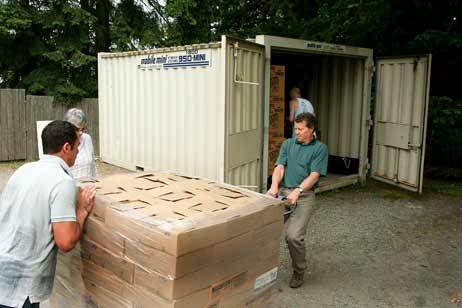What would hungry Americans do if it weren’t for the vast food bank system operating in this country?
Eat less.
It’s as simple as that, which is a cold, hard fact that serves as a driving force behind a Bainbridge Island nonprofit company that coordinates the donation of as much as four million pounds of protein-rich canned seafood annually.
Since islander Tuck Donnelley started SeaShare in 1994, it’s estimated that some 135 million seafood meals have been served to people who depend on food assistance – thanks in part to the mission of the 501(c)(3)nonprofit organization.
SeaShare’s staff is tiny, with only two full-time employees, but its influence resonates across the country.
Essentially, SeaShare, which is run now by Jim and Mary Harmon, is a hunger-relief purveyor that relies on the philanthropic nature of the seafood industry service and suppliers to provide canned food at no cost to those who need it the most.
SeaShare’s undertaking begins with fish – raw or frozen – caught and then donated by fishermen and processors that decided some 15 years ago to stop discarding product that could be processed, placed in cold storage, packaged and distributed to the thousands of small food banks and pantries that are fed daily by the nonprofit giant, Feeding America.
With very little money actually exchanged, SeaShare’s synchronized efforts help feed the nation’s hungry through social service food banks such as the one at Helpline House, which, ironically, is located just around the corner from the Harmons’ office at 600 Ericksen Ave.
Donnelley, who is retired but still serves on SeaShare’s board of directors, believes the industry became involved because it realized that it “was good for the public and for the industry,” which for years had been criticized for the amount of product it wasted. And now, there’s no turning back.
“In reality, the fishing industry is made up of people who value their community a lot and try to give back when they can,” said Harmon, who worked until 2000 – when he joined SeaShare – for a Seattle-based company that operated large factory trawlers in Alaskan waters. “Fishermen also respect the resource and rather than throw it overboard they prefer giving fish away to those who need it.”
Not that doing a good deed has become easier in these difficult economic times.
“We peaked at 4 million pounds a few years ago and we were down to 2 1/2 million last year,” said Harmon, whose expertise is product distribution and logistics. “Whether it’s seafood or dollars, the same number of people are donating less.”
Donnelley said most seafood-related companies still believe in the vision, “but in this economy production costs have gone way up and the ability for companies to provide the same poundage has gone down. And the need is going up at the same time.”
It’s bad news all around for this supposed land of plenty. More people are out of work and those who have jobs are often earning less.
The general cost of living continues to climb, especially basics like food and fuel. Thus, there has been a dramatic rise in people served by food banks, which are finding it increasingly difficult to meet current demands.
What’s a nonprofit to do?
SeaShare’s response, Donnelley said, has been to raise more funds in order to pay down some of the spiraling costs.
“Our financial support is still primarily coming from foundations and corporations,” he said. “But we are increasing our efforts to get seafood companies to help us with money contributions, too.”
They are willing, he said, but not always able. But every little bit helps
For example, Kraft Foods gave the nonprofit a grant used to buy processing machinery that allowed a seafood plant in Alaska to manufacture salmon patties specifically for SeaShare.
“We’re doing OK because we are doing something that nobody else is doing in the seafood industry and we are doing it with a very low overhead,” Donnelley said. “We’re not on the ropes by any means. We’ll find a way because the need is there and people still really care.”
And the giving continues.
Earlier this week, a truck delivered 4,752 cans of wild Alaska salmon to Helpline House as part of the Fill the Bus donation campaign in which students at Woodward Middle School have participated for the last five years. The pallet of canned food was too large to fit into the “bus,” so the Harmons had it delivered directly to Helpline House.
Harmon said his three children have all been involved in the campaign while attending Woodward because they also have the spirit of giving.
When asked about the path that brought the Harmon family to Bainbridge, he said it wasn’t a difficult decision.
“I used to spend a lot of hours in Seattle helping others make a lot of money,” he said. “Then Tuck Donnelley offered us this opportunity and now I live where I can be involved with my kids every day and help SeaShare make a difference.”


